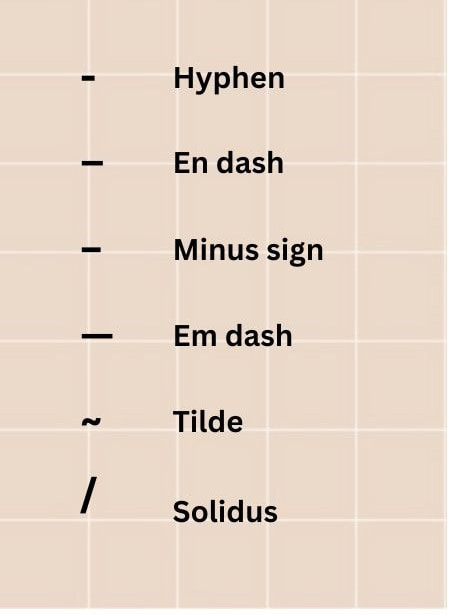|
As a copy editor, one of the most common punctuation mistakes I encounter in STEM writing is the use of a hyphen when an en dash is needed. Do you know how to correctly use the en dash in scientific writing? Read on to learn how and when to use this misunderstood punctuation mark.
What is an en dash?
Can you pick out the en dash from the picture? Here’s a hint: longer than a hyphen, but shorter than the em dash. And not to be confused with the minus sign. Common knowledge says that the en dash is so named because it is the approximate width of “N”. However, the name origin is more complicated. As described by Matthew Butterick in hyphens and dashes, “em and en refer to units of typographic measurement, not to the letters M and N.”
According to the Chicago Manual of Style (CMOS), the authoritative style guide for writers and editors that I describe here, "Hyphens and the various dashes all have their specific appearance…and uses…. The hyphen, the en dash, and the em dash are the most commonly used. Though the differences can sometimes be subtle—especially in the case of an en dash versus a hyphen—correct use of the different types is a sign of editorial precision and care." In UK English style the en dash with space before and after replaces the em dash, but this use of the en dash won’t be discussed further because it is atypical in US English style. How to us the en dash in science writing?
Recently, when I wanted to reviewing the rules on en dash usage in science writing, I grabbed my copy of the “Best Punctuation Book, Period” by June Casagrande. I love this book. It is very readable and easily searchable. Casagrande has a section for each punctuation mark, which includes a Punctuation Panel’s, made up of professional copy editors in news media and book publishing, preferred usage of the mark. As expected, the chapter on the en dash is quite short. However, I did a double take when I read, “The en dash…applies solely to book style. It does not exist in news, science, or academic style.” WRONG!
The en dash has very specific uses in STEM writing. The en dash is used to
Use in compound adjectives
Both CMOS and the American Medical Association (AMA) Manual of Style 11th edition prescribe use of the en dash when the compound adjective has an open element or already-hyphenated element. This helps avoid ambiguity.
For example: From CMOS, Chuck Berry–style lyrics (here, the name “Chuck Berry” is a known open unit, but it is a compound adjective with “style”) From the AMA, non–English-language journals Indicates equal weight
When a compound adjective has two components that have equal weight, the en dash is used. The American Chemical Society (ACS) and the American Psychological Association both describe this usage, known as the peer en dash. This includes collaborators of scientific findings or joint authorships.
Here are examples.
Numerical ranges
Another use of the en dash is to indicate inclusive numerical ranges (no spaces before or after the en dash). Use it for dates, times, data, and so on.
“The graph shows the mean of the data from multiple biological replicates (n = 3–6).” However, don’t use the en dash when “from” precedes the range—the word “to” is used instead. “Participation in the study was measured from May 2010 to April 2012.” Furthermore, if one of the numbers is negative, then the en dash should not be used. “Over the last week, temperatures were −10 to 23 °F.” Not “−10–23 °F”. Follow your style guide of choice to determine if units need to be repeated within numerical ranges. Of note, the AMA style guide 11th edition uses hyphens for numerical ranges. WEIRD! Chemical Bonds
Perhaps my favorite use of the en dash is in the chemical bond as prescribed by ACS. This is near and dear to my heart as I spent 6+ years working in chemistry and chemical biology. Here the en dash indicates a single covalent sigma bond.
H3C–OH R2C–C(H)=O Notice that the equal sign (same width as the en dash) denotes a double covalent pi bond. Yes to the en dash!
The en dash has specific uses in science, and it’s important for clarity, formality, and professionalism to understand the different uses. Although CMOS recommends using other punctuation instead of the en dash or completely recasting the sentence, I suggest using the en dash without reservation. What do you think?
0 Comments
Leave a Reply. |
AuthorSusan is a scientist turned writing service specialist. Her interests include the clear communication of scientific research and complex subjects. Archives
June 2024
Categories
All
|



 RSS Feed
RSS Feed